What 2010's End is Saying About 2011's Stock Market Trends
Stock-Markets / Stock Markets 2011 Dec 27, 2010 - 06:12 AM GMTBy: Money_Morning
 Jon D. Markman writes:
Stocks rose last week with all the excitement of water turning to ice in the freezer.
Jon D. Markman writes:
Stocks rose last week with all the excitement of water turning to ice in the freezer.
I kept hitting the side of my monitor to see if the pixels were stuck -- but no, it was just another one of those low-volume, low-drama late-December sessions that we have come to know and love.
The Dow Jones Industrial Average rose 0.12%, the Standard & Poor's 500 Index fell 0.16%, the Nasdaq Composite Index fell 0.08% and the Russell 2000 small caps fell 0.2%. Overseas developed and emerging markets were exactly the same. The liveliest U.S. sector was health care and basic materials, up 0.2%, while financials and industrials lagged, down 0.4%.
Breadth slightly favored decliners over advancers by a 3-2 margin, and the number of new highs was way down at 394 -- yet so was the number of new lows, at 34. Gold fell by 0.4%, crude oil jumped out to a new two-year high by 1.1%, to $91.51, and the grains jumped to a new one-year high as well, led by corn.
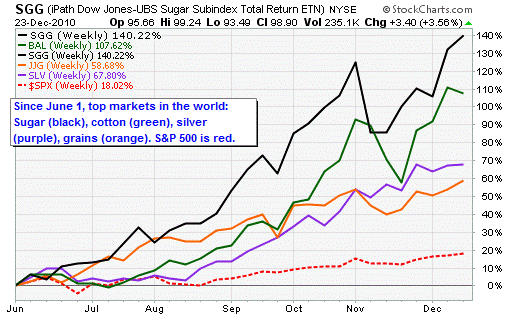
The new star of the show for commodities is sugar, which stormed out to a new high by 1.9% after word that a cold front had virtually wiped out Florida's sugar cane crop, which is the largest in the United States. As you can see in the chart above, an exchange-traded fund (ETF) representing sugar is up 140% since June alone, beating out cotton (green line), up 101%, silver (purple line), up 68%, and grains (orange line), up 58%. And of course all of these commodities have handily beaten U.S. equities (red dotted line), up 18% in the past seven months.
I wrote about the potential for sugar back in April 2006 in this column at MSN Money. It's ironic that a commodity which is given away at every restaurant in the world could at the same time become the most valuable. The main reasons: rising demand for sugar cane as an efficient feedstock for engine fuel, as well as the burgeoning sweet tooth among the rising middle classes in Asia.
Quick side note: Cane is popular as an energy feedstock in Brazil because it results in a huge net positive energy gain: about 8:1 energy output to energy input. Contrast that with corn, used in this country as the feedstock for ethanol, which requires more energy to make than it creates. Corn is an absolutely ridiculous fuel source, and yet it persists due to massive government subsidies lavished on the Midwest by politicians desperate to cultivate the farm vote.
In that column, which mind you was written four years ago, I quoted commodity speculator James Rogers as stating that the rally for sugar "hasn't even started yet, and the fundamentals are changing dramatically in a positive way. It could quadruple from here." Sugar is up about 525% from 2000, but only up double from 2006. So if Rogers was right, then it still has a long way to go. I'll look for a place to recommend the iPath DJ-UBS Sugar Subindex Total Return (NYSE: SGG) exchange-traded fund in 2011.
Economics this week revealed nothing earth-shaking. Personal income was reported up 0.3%, while consumption was up 0.4%. Durable goods orders for November fell 1.3%, a little more than expected, but most of that was a shortfall in orders for The Boeing Co. (NYSE: BA) planes. Outside of transportation, durable goods orders rose 2.4% in November. Initial jobless claims for last week were down a touch. Consumer sentiment was reported up to a new five-month high, which is good. And new home sales were a little disappointing - though what's new.
In Europe, the main market-driving news this week continues to be the weather. It's bad. Ach du lieber! The wire services reported late Thursday that more than 1,000 flights at Germany's major airports were canceled and hundreds more were delayed as fresh snow and ice blanketed the country. Heavy snow continued to fall in parts of England and France, creating blizzard conditions in some areas, the wires said, canceling one-fifth of flights at Paris-Charles de Gaulle Airport.
Travel was disrupted on the high-speed trains through the France-England Channel Tunnel and German national railway company Deutsche Bahn reported that it also struggled with packed trains and angry travelers. Freezing rain in northern Germany created more than an inch of ice on some main roads.
I'm telling you this because bad weather tends to have a heavy impact on retail sales. If both U.S. and European consumer products makers experienced depressed sales, analysts are going to be out in the next two weeks lowering earnings estimates. That could have a negative effect on stocks early in January, so let's be on our toes and ready for that.
Remember that following NIKE Inc.'s (NYSE: NKE) warning of weaker sales in China, we are already on high alert for softer sales by its fellow exporters. I suspect that Beijing's clampdown on credit is impeding retailers across China from stocking their shelves not just with Nikes but with all kinds of discretionary goods such as soaps, electronics, branded clothes and non-staple foods, like sodas.
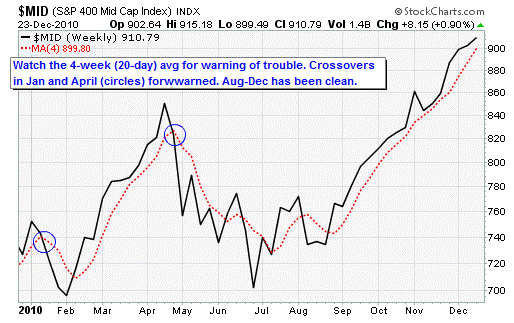
Going forward into 2011, we need to keep a close eye on the market's 20-day average, which I have represented above in the chart of the S&P 400 Midcap Index as the four-week average to make it easier to see. Bad trouble always starts with a little trouble. And little trouble is always signaled when a weakening market trades under its 20-day average at the end of a week.
No moving-average crossover system is perfect, but these kind of momentum shifts can at least tell you to lighten up on positions and don't add anything new. You can see that the S&P 400 lost its four-week average in the winter and spring at the spots marked by the circles. It's a good time to just batten down the hatches, grit your teeth, maybe put on a short position if you're feeling frisky.
In this context, when you look at the chart it's quite impressive that the entire rally since September has occurred over the four-week average. Let's hope this continues well into the new year, while at the same time preparing to take action to protect profits in case of a stumble.
You know the larger forces at work in the market -- hedge funds, pension funds, the Syndicate, if you will -- periodically like to scare the little guys out of the market so they can scoop shares up cheap. It's mean and rotten, but that's the way it is. We don't make the rules, we just learn how to recognize and exploit them.
The most likely time for such a stumble would be the third week of January, but if those weather-related earnings cuts materialize a slip could come much sooner. The magnitude could be as much as 400 to 600 points in the Dow Jones Industrials, or -3.5% to -5.5%. That would be scary, but in my estimation not permanent -- and I anticipate recommending that you eventually use it as an opportunity to buy. We managed to do that at the August low and the November low by pointing out the clear patterns of methodical institutional accumulation amid general panic, and should be able to do it again. We just need to think like predators instead of prey.
Banksters On the Move
Macro risk in Europe and China mostly simmered over the past week, and here's a new one: politicians in Washington finally stopped arguing for a few days and actually got some work done. The new nuclear arms treaty doesn't appear to add much directly to businesses, but it does help ratchet down the level of tension between two atomic superpowers, which provides a positive undercurrent. When people feel less threatened by nuclear annihilation, they feel more comfortable about investing in their future.
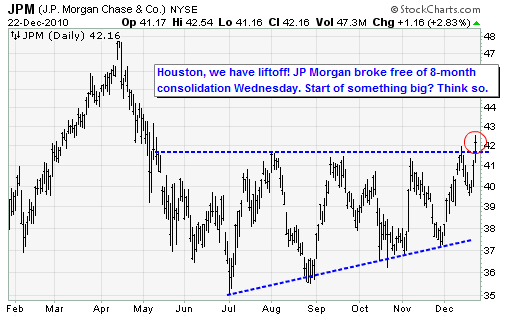
Banks have been one of the shining graces of the market, which is rather stunning when you think about it. It's mostly a result of brokerages announcing upward revisions to earnings estimates for 2011, more acquisitions of the weak by the strong, and a sense that the residential real estate market won't get too much worse, which means that it can start getting better.
And there was even a sliver of a glimmer of hope that mega-banks like JP Morgan Chase & Co. (NYSE: JPM) might consistently make money without government support. JPM - the top holding in our SPDR KBW Capital Markets fund (NYSE: KCE) - broke out of the loooong consolidation we've been talking about for months, as shown above. Bulls will aim at the April high of $48, and I have little doubt they will get there.
Home builders enjoyed a good session, but they have had so many false starts it's hard to pay attention. In case you want to peek, however, top names at the moment are Standard Pacific Corp. (NYSE: SPF), Meritage Homes Corp. (NYSE: MTH) and Lennar Corp. (NYSE: LNR).
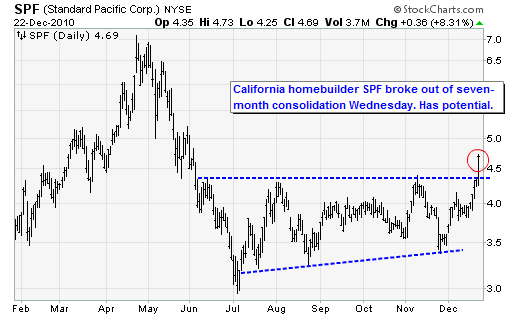
Check out the chart of California-based homie SPF, above. That's a very attractive breakout. Standard Pacific shares' seasonality is very strong from now through the next five to nine weeks. Risk-takers may wish to consider the January $4 calls on dips, which are now going for 70 cents, or for more time, the March $5s, going for 35 cents.
I can hear the groans. Who would want to speculate on California right now, right? I mean, unemployment is off the charts, the state is broke, and home inventory is high due to rampant foreclosures. All true. However .....
Quick anecdote: I was cleaning out a closet at home yesterday when I ran across a newspaper that we saved from the day my son was born in September 1992. There is a photo of a very youthful looking Bill Clinton on the front page, and here are some headlines from the paper:
•"Fiscal Outlook for State Still Shaky."
•"Number of Poor in America Hits 27-Year High."
•"L.A. County Starts Avalanche of Fee Hikes."
•"Delinquency in Home Loans Jumps Sharply."
•"Retailers Say Sales Rose Modestly in August."
Okay, you get the point. Now turn to the stock pages. The Dow Jones Industrials then was at 3,292.20. It's up 3.5 times as much since. Crude oil was at $21.67, the 30-year bond yielded 7.3% and gold was at $340. Yeah; things worked out okay.
Cursory analysis shows that the stocks that performed best in the aftermath of that period were the big banks like JPM, new techs like Cisco Systems Inc. (Nasdaq: CSCO), and energy conglomerates like Occidental Petroleum Corp. (NYSE: OXY). I would not be surprised if this history lesson were to repeat over the next decade as we transit out of a period of want and fear to a period of increasing plenty and confidence.
Exxon Goes Mobile
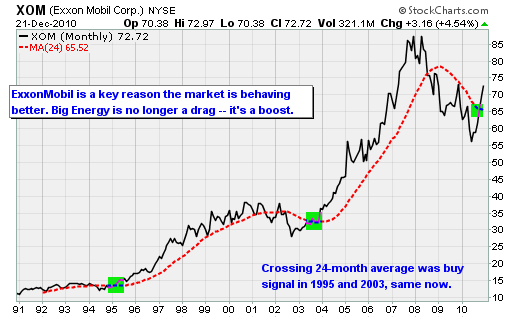
One of the most important developments of the past week was the newfound strength of big-cap energy, such as Exxon Mobil Corp. (NYSE: XOM) and Chevron Corp. (NYSE: CVX), which are among the largest weightings in the S&P 500 and Dow Jones Industrials Average. These stocks have been a massive drag to the indexes for the past two years. The Dow and S&P 500 have been lugging around these dead weights, severely hampering their performance.
As you can see above, XOM did not bottom in March 2009 with everything else -- it bottomed in July of this year. If these stocks can maintain their momentum, the broad market will have a much easier time achieving our upside goal for the S&P 500 in 2011, which is 1,400.
What's the central theme here? Well, my friend Terry Bedford, who runs a hedge fund in Toronto, calls stocks' action this week a great example of an "objects in motion" trade. He's referring to Sir Isaac Newton's first law of motion, the foundation of mechanics. The layman's version of Newton's first law is that a "body" -- a particle, a stock, a major league baseball -- remains in a state of uniform motion until it is acted upon by an external unbalanced force.
Another way to say that is, "the trend is your friend until it ends." Or as Jesse Livermore would put it, "the path of least resistance is higher." All of which reminds me of the third law of financial writing: For every action there is an equal and appropriate cliche.
Bottom line: When markets are performing poorly, we spend a lot of time analyzing the economy, mulling over credit default swaps, talking about politics and generally trying to find reasons stocks aren't moving. When markets are performing well, it's better not to think too much. Just go with the flow, find stocks and funds that are rebounding amid uptrends, and enjoy the calm while it lasts.
Nike On the Run
Consumer goods makers struggled following a kick in the shins by athletic shoe maker Nike, which reported earnings that were a touch weaker than expected.
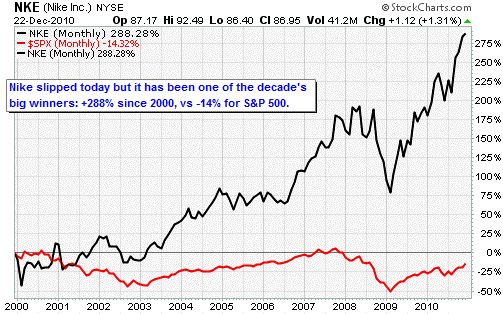
Check out the Nike chart and think about this: The stock has been so powerful that if you had bought the top tick of NKE shares for each annual rally of 2000-2010 you would still be well ahead now. That's the power of a brand. Apple Inc. (Nasdaq: AAPL) has it. The Coca-Cola Company (NYSE: KO) has it. Amazon.com Inc. (Nasdaq: AMZN) has it. Buying the top brands in a consumer society, especially on big declines, will always work.
So what happened to Nike in the past quarter? When you look at why NKE failed to exceed expectations as much as bulls expected you get a quick lesson in the interconnectedness of markets today. Shares fell 5.8%, the biggest drop since March 5, 2009, the day before the bear market low, due in large part to concerns of a slowdown in orders in China and emerging markets.
This is more a reflection of the clampdown on credit in China than it is a reflection of demand. The company did not say so explicitly, but the rising price of raw materials and the narrowing of credit availability probably made it harder for Chinese retailers to stock Nikes in the past quarter. If that's true, then a lot of the themes that we've been talking about are starting to come together. Higher prices virtually always curb demand, whether you're talking about crude oil or sneakers. This could be a very serious headwind for U.S. exporters heading into next year.
Submerging Markets
Would you believe that Peru is most likely going to win the crown as the emerging market with the best market gains for the year, up 56%? Strange but true, amigos. It's followed by our favorites, Thailand (NYSE: THD), +54%; Colombia(NYSE: GXG), +50%; and Chile (NYSE: ECH), +44%.
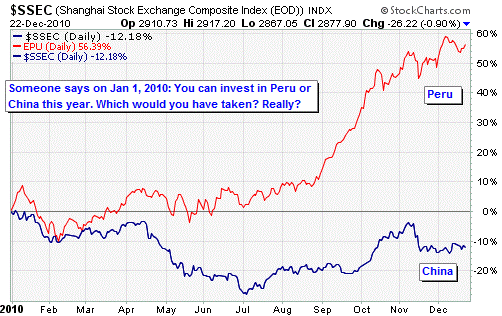
Indonesia (NYSE: IDX) started the year well but ended the year by flat-lining since September, and is now only up 37%. India (NYSE: EPI) stormed out to a 30% gain by early November but tipped over since to close up only 17%; we took out a nice profit in that before it collapsed.
Malaysia (NYSE: EWM) will end up 35%, but without a lot of histrionics; it is slow but steady. Turkey (NYSE: TUR) rose as much as 45% mid-year but will end up around 24%; we took a nice profit out of that in the summer too before it was cut in half.
Bringing up the rear among the emerging markets are Brazil (NYSE: EWZ) and China, locked together at just 3.6%. Did you ever imagine that Brazil and China would be laggards in the second year of a recovery? I sure did not, but fortunately my ETF model never liked either of them and they were avoided all year in favor of markets in Southeast Asia and the Andes of South America. Sometimes the algorithms just know these things. I've learned to trust them, and so should you.
The Week Ahead
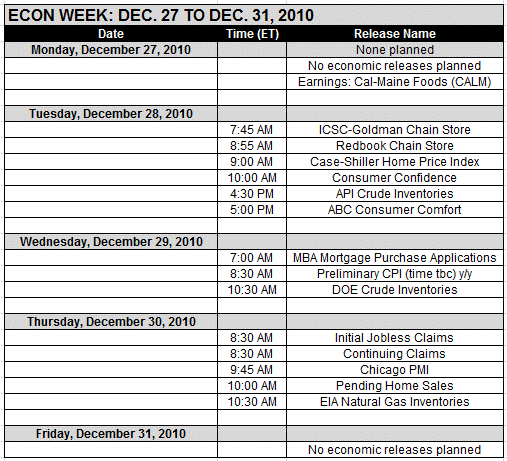
[Editor's Note: Money Morning Contributing Writer Jon D. Markman has a unique view of both the world economy and the global financial markets. With uncertainty the watchword and volatility the norm in today's markets, low-risk/high-profit investments will be tougher than ever to find.
It will take a seasoned guide to uncover those opportunities.
Markman is that guide.
In the face of what's been the toughest market for investors since the Great Depression, it's time to sweep away the uncertainty and eradicate the worry. That's why investors subscribe to Markman's Strategic Advantage newsletter every week: He can see opportunity when other investors are blinded by worry.
Subscribe to Strategic Advantage and hire Markman to be your guide. For more information, please click here.]
Source : http://moneymorning.com/2010/12/27/...
Money Morning/The Money Map Report
©2010 Monument Street Publishing. All Rights Reserved. Protected by copyright laws of the United States and international treaties. Any reproduction, copying, or redistribution (electronic or otherwise, including on the world wide web), of content from this website, in whole or in part, is strictly prohibited without the express written permission of Monument Street Publishing. 105 West Monument Street, Baltimore MD 21201, Email: customerservice@moneymorning.com
Disclaimer: Nothing published by Money Morning should be considered personalized investment advice. Although our employees may answer your general customer service questions, they are not licensed under securities laws to address your particular investment situation. No communication by our employees to you should be deemed as personalized investent advice. We expressly forbid our writers from having a financial interest in any security recommended to our readers. All of our employees and agents must wait 24 hours after on-line publication, or 72 hours after the mailing of printed-only publication prior to following an initial recommendation. Any investments recommended by Money Morning should be made only after consulting with your investment advisor and only after reviewing the prospectus or financial statements of the company.
Money Morning Archive |
© 2005-2022 http://www.MarketOracle.co.uk - The Market Oracle is a FREE Daily Financial Markets Analysis & Forecasting online publication.



